
How psychology works the facts visually explained (DK) (Z-Library)
.pdf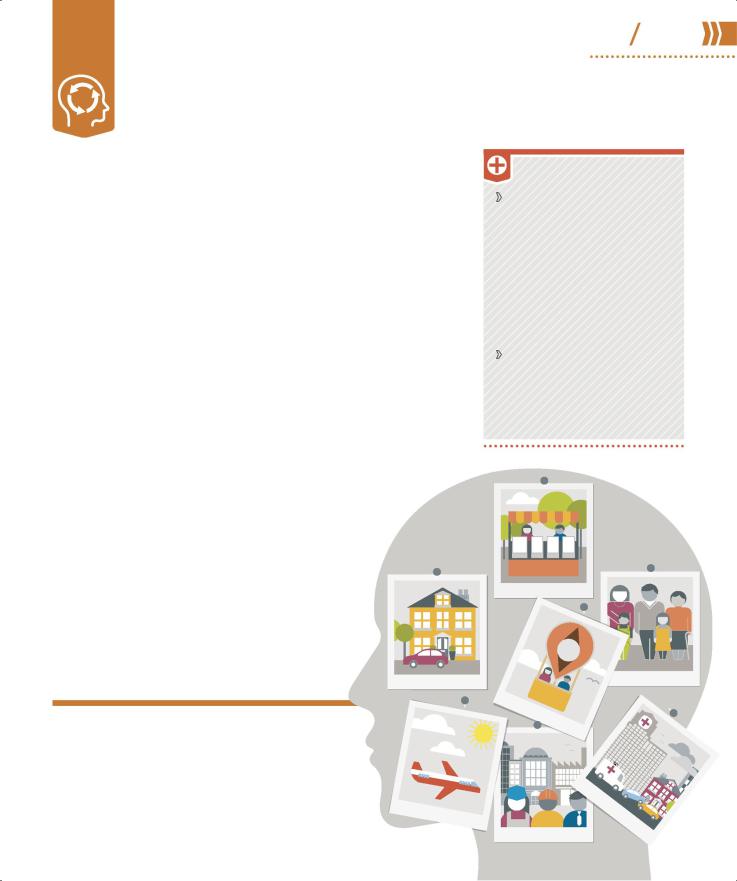
Dissociative amnesia
This is an often short-term, dissociative disorder in which a person becomes separated from their personal memories following stress, trauma, or illness.
What is it?
Dissociative amnesia is often linked to overwhelming stress, such as witnessing or suffering from abuse, an accident, or a disaster. The resulting severe memory loss often affects specific recollections, such as a certain period during childhood, or something associated with
a friend, relative, or peer. Alternatively, the amnesia may focus on a traumatic event, for example, a crime victim may have no memory of being robbed at gunpoint, but can recall details from the rest of that day. A person may develop generalized memory loss and may not
remember their name, job, home, family, and friends. They may disappear and be reported missing. They might even create a totally new identity, fail to recognize people or places from their past life, and be unable
to explain themselves—this is known as a dissociative fugue.
Clinical diagnosis will involve completing assessment
questionnaires that help identify a trigger and enable the individual to capture and rate their symptoms.
Physical checks and psychological examinations are also carried
out to exclude other medical causes of memory loss.
2−7%
of people have dissociative amnesia
Memory recovery
Most cases of dissociative amnesia are shortterm, and while memories may temporarily fall away, they often return suddenly and completely. The recovery may happen on its own, after being triggered by something in the person’s surroundings, or in a therapy session.
88 89
TREATMENT
Psychotherapies, such as cognitive behavioral therapy, dialectical behavior therapy, eye movement desensitization and reprocessing, family therapy, and art therapies such as hypnosis or mindfulness meditation can help the person understand and deal with the stress that triggered the disorder, and learn coping strategies (pp.118−141).
Medication, such as antidepressants, may be prescribed for the depression or psychosis that can be associated with the amnesia (pp.142−143).

Anorexia nervosa
With this serious emotional disorder, a person wants to weigh as little as possible. They develop an aversion to food and their appetite reduces as they eat less and less.
What is it?
A person with anorexia becomes so afraid of gaining weight that they cannot eat normally. They may take appetite suppressants, laxatives, or diuretics (to remove body fluid), or make themselves vomit after meals (bulimia nervosa, pp.92−93), but they may also binge (binge-eating disorder, p.94).
Many factors can trigger anorexia. Pressures at school, such as exams or bullying (particularly if the focus is on body weight or shape), can contribute, as can occupations such as dancing or athletics where being thin is considered “the ideal.” The disorder can also be a response to stress in childhood or lack of control
TREATMENTS
Multidisciplinary care team, including a GP, psychiatrists, specialist nurses, and dietitians to ensure that a person gains weight safely and to support family and close friends.
Cognitive behavioral therapy
(p.125) to help the person understand and explain their problem and see it as a cycle of triggers, thoughts, feelings, and behaviors. Therapist and patient collaborate on interventions that break the chain of thoughts maintaining anorexia.
Cognitive analytic therapy to examine the way the person thinks,
over life events, such as losing a job, relationship breakdown, or bereavement, which makes the person exert excessive control over internal processes that are within their power.
Anorexia affects more females than males. Many of those who develop it share personality and behavioral traits. They are often emotionally controlled, have a tendency toward depression and anxiety, find it difficult to handle stress, and worry excessively. Many individuals set themselves strict, demanding goals. They may have feelings of obsession and compulsion, but not necessarily OCD (pp.56–57). Living with
feels, and acts, as well as the events and relationships that underlie their past experiences—often
in childhood.
Interpersonal therapy to resolve problems with attachment and relating to other people.
Focal psychodynamic therapy to explore how early-childhood experiences may have affected the person.
In-patient treatment for severe cases; supervised weight gain through strict daily routines and eating plans, often including group therapy for peer support.
anorexia can make it hard to maintain relationships. It can also have an irreversible impact on the body and cause infertility or serious pregnancy complications.
How is it diagnosed?
The GP, clinical psychologist, or specialist health professional asks the individual questions about their personal and family history, weight, and eating habits. The person needs treatment as early as possible to reduce the risk of complications. In most cases,
the treatment plan involves psychotherapy and individually tailored advice on eating and nutrition. Recovery can take years.
Symptoms of anorexia
All symptoms relate to self-esteem, body image, and feelings, and divide into three main categories: cognitive (feelings and thoughts), behavioral, and physical.
46%
of people with anorexia recover fully
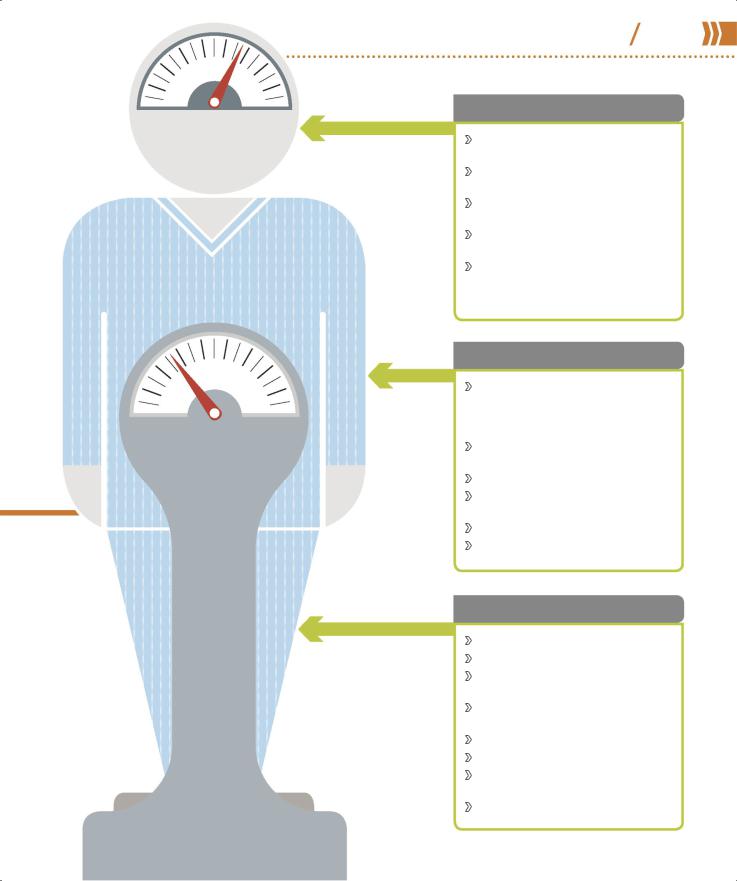
Perceived body weight is too high and the person feels compelled to lose weight.
Actual body weight and BMI are much lower than is healthy for their age and height.
PSYCHOLOGICAL DISORDERS |
90 91 |
Anorexia nervosa |
Cognitive symptoms
Expresses a fear of gaining weight and becomes obsessed with body shape.
Believes that being thin is good and is convinced that they are overweight.
Measures self-worth in terms of body weight and shape.
Obsesses about food and the perceived negative consequences of eating.
Becomes irritable, moody, and unable to concentrate (partly due to hunger), which impacts school or work.
Behavioral symptoms
Behaves obsessively around food and diets, and counts calories excessively. Avoids “fatty” foods and/or eats only low-calorie foods. May skip meals.
Avoids eating in front of others, and/or purges after eating.
Lies about how much they eat.
Repeatedly weighs themselves or checks their body shape in the mirror.
Exercises obsessively.Becomes socially withdrawn.
Physical symptoms
Obvious weight loss.
Irregular or absent periods in females.
Poor dental health and smelly breath due to persistent vomiting.
Soft, fine, “downy” hair growing on the body, while head hair falls out.
Has difficulty sleeping but is very tired.Is weak, light-headed, and dizzy.
Has stomach pains, and is constipated and bloated.
Has swollen hands and feet.
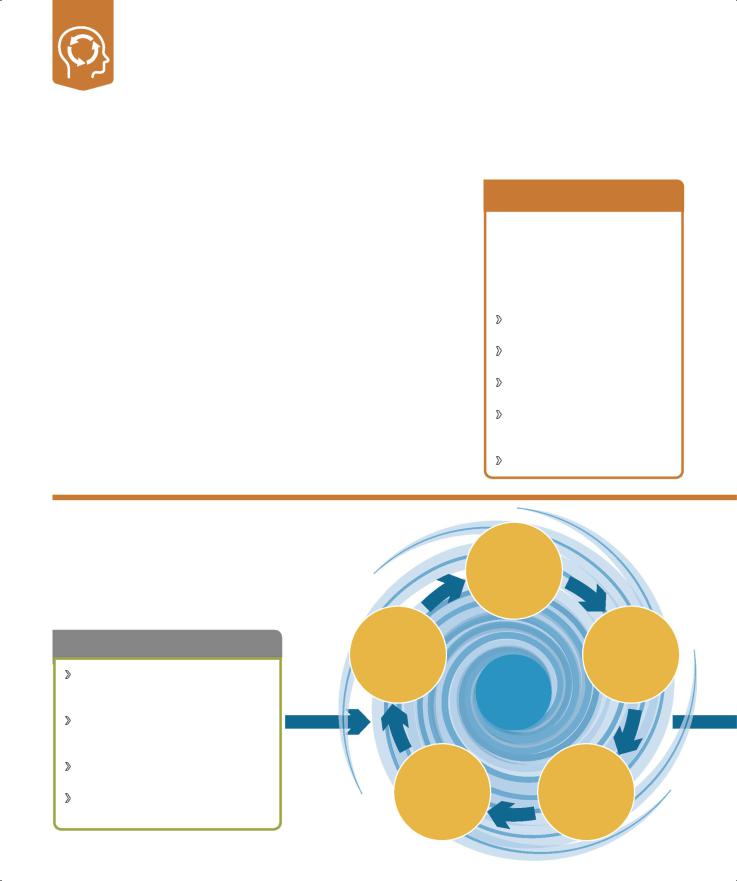
Bulimia nervosa
A serious eating disorder, bulimia is characterized by a person controlling their weight through severely restricting intake, then binge eating and purging the body of the food.
What is it?
People with bulimia have an abnormal fear of putting on weight and so become obsessed with food and dieting. Unlike those with anorexia (pp.90–91), they are usually at or near a normal weight for their height and build. However, like a person with anorexia, they have a distorted self-image and believe they are too fat.
A person with bulimia may often appear tense or anxious and behave furtively, rapidly consuming large amounts of food in secret before disappearing to the bathroom to make themselves vomit. This behavior is a mechanism for coping with life
events—although in fact it makes daily living a struggle—and is linked to depression, anxiety, and social isolation. Pressure to conform to body shapes promoted by the fashion and beauty industries and a family history of bulimia increase the risk. Bulimia is more common in females, but incidence in males is rising. Puberty and selfconsciousness are often triggers, and boys and girls in their teens are especially vulnerable to bulimia if teased as an overweight child.
Bulimia can cause irreversible damage to the heart, bowels, teeth, and fertility. Treatment depends on the severity of the condition, and recovery can be a long process.
DIAGNOSING BULIMIA
Doctors all over the world use the so-called SCOFF questionnaire (developed in the UK) to diagnose anorexia (pp.90–91) or bulimia. Two or more “yeses” indicate a likely case.
Does the person make themselves Sick (vomit) after eating?
Has the person lost Control over how much they eat?
Have they lost more than One stone (13lb) within three months?
Does the person believe they are Fat even though others have told them they are too thin?
Does Food dominate their life?
Binge−purge cycle
The person has a low self-opinion and sees losing weight as a way of gaining selfworth. They may also exercise fanatically to burn off the additional calories and avoid social occasions that involve food.
Causes
The individual may have a caregiver who thinks looks are important and criticizes their weight or appearance.
The person may want to take control of an aspect of their lives, particularly if recovering from a traumatic event.
Images of celebrities with flawless, thin bodies trigger the start of a strict diet.
Despair sets in when the person cannot keep to the diet.
Food cravings set in, which before long are irresistible.
A strict diet |
|
Bingeing |
seems to be the |
|
provides |
best solution |
|
temporary |
to avoid weight |
|
relief from |
gain. |
LOW |
unhappiness. |
|
SELF- |
|
|
ESTEEM |
|
Guilt and |
Purging brings |
shame result |
a short-term |
from the purging, |
respite from the |
leading to |
fear of gaining |
depression. |
weight. |

TREATMENT
Psychotherapies such as group therapy, self-help, or one-on-one cognitive behavioral therapy (p.125) or interpersonal therapy.
Antidepressants (pp.142−143) prescribed along with therapy.
In-patient treatment needed in extreme cases.
1.5%
of American women have or have had bulimia in their lifetime
Physical effects
Frequent weight gain and loss.
Bad breath, stomach pain, sore throat, and damaged tooth enamel from acid levels in vomit.
Dry skin and hair, hair loss, brittle nails, lethargy, and other signs of poor nutrition.
Heart strain, hemorrhoids, and weak muscles from misuse and overuse of laxatives and diuretics.
Irregular/absent periods in females.
Feeling bloated and/or constipated.
Bloodshot eyes.
Calluses on the back of hands from induced vomiting.
PSYCHOLOGICAL DISORDERS |
92 93 |
Bulimia nervosa |
PEOPLE WITH BULIMIA feel as if they have no control over eating habits, which increases their fear of weight gain.
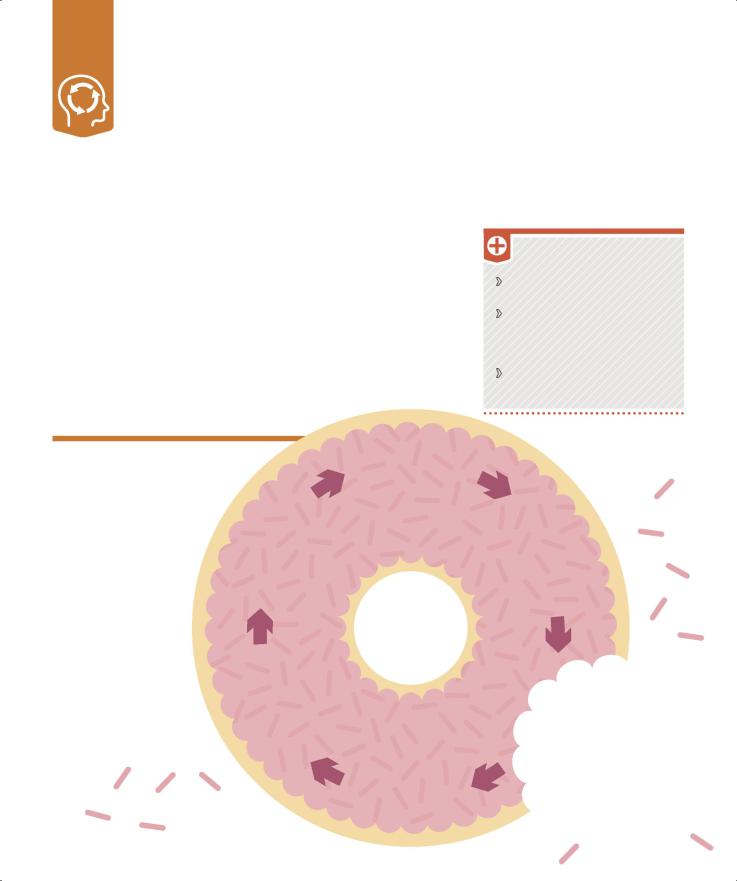
Binge-eating disorder
With this condition, a person regularly overeats to cope with low self-esteem and misery, although in fact the persistent, uncontrolled binge eating makes depression and anxiety worse.
What is it?
A person with binge-eating disorder regularly eats large amounts quickly when not hungry, alone or secretly, and feels shame and self-disgust after a binge. They feel they have no control over how much and how often they eat.
Low self-esteem, depression, anxiety, stress, anger, boredom, loneliness, dissatisfaction with the body, pressure to be thin, traumatic
events, and a family history of eating disorders are all factors that increase the risk of developing it. The disorder can also develop after the person follows such a strict diet that they are left very hungry and have food cravings. It is the most common eating disorder in the US.
A GP may diagnose the disorder from the person’s weight gain—the most common physical effect.
TREATMENT
Psychotherapy (pp.118–141) in groups or one-on-one.
Self-help programs through books, in online courses, as part of a support group, or supervised by a health professional.
Antidepressants (pp.142–143) prescribed along with therapy.
Bingeing cycle
People with a bingeeating disorder are using food as an instant, albeit negative, way to relieve emotional pain instead of finding positive methods of tackling
the underlying cause. The result is a perpetual cycle of eating, relief, depression, and yet more eating.
Anxiety rises and depression sets in as eating provides only short-lived “pain” relief.
Low mood returns with self-disgust because of the guilt and shame associated with binge eating.
Relief from increasingly distressing feelings comes only with thoughts of food.
The need to eat to relieve depression grows in urgency; the person plans a binge, often buying special foods for that purpose.
|
The person eats large |
|
amounts of food rapidly |
|
(regardless of degree of |
|
hunger), often in secret, |
Anxiety drops as |
may be in a dazed state |
eating temporarily |
while eating, and may |
numbs the feelings |
feel uncomfortably full |
of stress, sadness, |
afterward. |
or anger. |
|

Pica |
94 |
95 |
|
|
An individual with this eating disorder persistently eats substances that are not food, such as dirt or paint. It can lead to serious complications if the substance is dangerous when ingested.
What is it?
Children and adults with pica may eat, for example, animal feces, clay, dirt, hairballs, ice, paint, sand, or metal objects such as paper clips. It is more common in children than adults—between 10 and 32 percent of children age 1–6 years are affected by pica. The odd eating behavior can create complications such as lead poisoning or intestinal
damage from sharp objects.
For a doctor to diagnose pica, the pattern of behavior must last for at least one month. After a medical
examination to rule out causes such as nutrient deficiency or anemia
as the root of the unusual cravings, a specialist health professional evaluates the presence of other disorders such as developmental disabilities or OCD (pp.56–57).
28% of pregnant women are affected by pica
RARER EATING DISORDERS
TREATMENT
Behavioral therapies (pp.122– 129) to associate healthy eating with positive reinforcement or reward. Positive behavior support to address aspects of family and home environment and minimize recurrence.
Medication to enhance dopamine levels; supplements to remedy any nutrient deficiencies.
Irregular eating habits, eating unusual items, distress or avoidance around eating or mealtimes, or concerns about body weight or shape characterize eating disorders.
NAME |
WHAT IS IT? |
CAUSES |
SYMPTOMS |
IMPACT |
TREATMENT |
PURGING |
Deliberate |
Childhood abuse |
Vomiting after |
Anxiety, |
Management of |
DISORDER |
vomiting that |
or neglect, social |
meals, laxative |
depression, and |
medical problems, |
|
occurs often |
media stresses, or |
use, obsession with |
suicidal thoughts |
healthy eating plan, |
|
enough after eating |
family history |
weight/appearance, |
that affect |
nutrition education, |
|
to affect physical |
|
tooth decay, |
relationships, work, |
psychotherapy |
|
health |
|
bloodshot eyes |
and self-esteem |
|
NIGHT-EATING |
Urge to eat most |
Depression, low |
Insomnia, grazing |
Problems with |
Psychoeducation |
DISORDER |
of the daily food |
self-esteem, or |
in the evening, |
work, social, or |
about the disorder |
|
requirement during |
response to stress |
waking in the |
intimate |
and nutritional |
|
the late evening or |
or dieting |
night to eat |
relationships; |
and behavioral |
|
at night |
|
|
weight gain or |
therapy |
|
|
|
|
substance abuse |
|
RUMINATION |
Tendency in young |
Neglect or |
Regurgitation and |
Usually outgrown |
Family therapy and |
DISORDER |
children who |
abnormal |
rechewing food, |
in early years; if it |
positive behavior |
|
have intellectual |
relationship with |
weight loss, poor |
persists, impacts |
support |
|
disability to rechew |
parent or caregiver; |
teeth, stomach |
daily life |
|
|
partly digested |
may be attention |
pains, raw lips |
|
|
|
food |
seeking |
|
|
|

Communication disorders
This range of conditions affects a person’s ability to receive, send, process, and/or understand verbal, nonverbal, and visual concepts and may be apparent in hearing, language, and/or speech.
What are they?
The four main conditions are language, childhood fluency, speech-sound, and SCD (social communication disorders). They are often complex. Some are apparent in babies and toddlers, whereas others may not become obvious until a child is at school.
The causes are wide-ranging. Communication disorders may develop of their own accord or stem from a neurological illness. They can be genetic—20–40 percent of children with a family history of speech and/or language impairment have communication disorders. Prenatal nutrition may
be involved. Psychiatric disorders, ASD (pp.68–69), Down syndrome, cerebral palsy, and physical problems including cleft lip or palate and deafness may limit a person’s ability to communicate.
How are they diagnosed?
To maximize a child's development potential, early intervention is important; some conditions require lifelong management. A speech and language specialist takes a case history, including information about family background, medical conditions, and information from teachers and caregivers, to prepare a treatment plan.
TREATMENT
Speech and language therapy essential to help language skills, speech-sound production and rules, fluency, and nonverbal gestures; for stutterers, support to control and/or monitor rate of speech and breathing.
Positive behavior therapies to improve the relationship between behavior and communication.
Family therapy, special educational support, and environmental adaptations to support language development.
CAUSES OF COMMUNICATION DISORDERS
More than one causal factor may be involved and the effects can range from mild to profound.
DISORDER
LANGUAGE DISORDER
TRIGGER |
FAMILY HISTORY OF LANGUAGE IMPAIRMENTS |
CHILDHOOD DEVELOPMENT DISORDER |
GENETIC SYNDROME |
IMPAIRED OR NO HEARING |
EMOTIONAL OR PSYCHIATRIC DISORDER |
PREMATURE BIRTH |
NEUROLOGICAL ILLNESS OR DAMAGE |
POOR DIET |
SPEECH-SOUND DISORDER
CHILDHOOD FLUENCY DISORDER
SOCIAL COMMUNICATION DISORDER
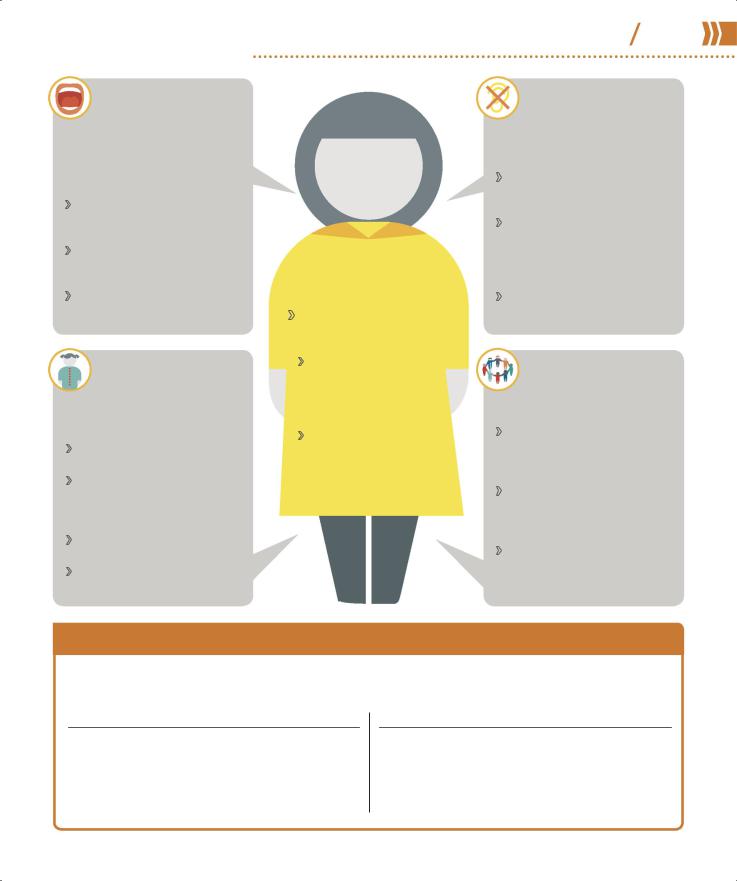
PSYCHOLOGICAL DISORDERS |
96 97 |
Communication disorders |
LANGUAGE
DISORDER
The child does not understand others (receptive disorder) or cannot communicate thoughts (expressive disorder) or both (receptive-expressive disorder).
Baby does not smile or babble in response to parents, and only has a few words by 18 months.
Child does not play with others and prefers to be alone. May become shy and distant.
Child has difficulty swallowing, affecting ability to speak.
CHILDHOOD FLUENCY
The child stammers or stutters, repeating words or parts of words, and prolonging speech sounds.
Speech can become blocked as if child is out of breath.
Child uses distracting sounds such as throat clearing or head and body movements to disguise their problem.
Anxiety is increasingly evident as child tries to hide disorder.
Child avoids public speaking as anxiety worsens the stutter.
IMPACT
ON THE
CHILD
Errors of thinking and communication affect daily
interactions. Children become anxious, with low self-confidence.
Developmental milestones are delayed as children learn through communication.
Social isolation occurs because child does not initiate interaction and cannot make friends. May become target of bullies.
Behavioral issues arise as child adopts avoidance
techniques and may become aggressive if they cannot resolve speech difficulties.
SPEECH–SOUND DISORDER
The child has difficulty articulating sound patterns and mispronounces words beyond expected age range.
Unclear speech, common in young children, continues beyond the age of eight.
Child unable to produce correct sound patterns even though they can understand speech, so cannot make themselves understood by others.
Limited understanding of rules of speech sounds is apparent.
SCD
The child cannot process verbal and visual information simultaneously.
Child cannot adapt language to suit situation, so can be dogmatic, dominating, and inappropriate when talking to adults or peers.
Child lacks nonverbal communication skills such as taking turns in conversation or other group activities.
Child cannot greet people as they have little or no interest in social interaction.
SOCIAL COMMUNICATION DISORDER OR AUTISM SPECTRUM DISORDER?
SCD (social communication disorder) has many symptoms in common with ASD (autism spectrum disorder). Assessment must rule out ASD before doctors diagnose the child with SCD and establish a treatment plan.
Social communication disorder
Children with SCD find it difficult to learn the basic rules of conversation: how to start one, listen, phrase questions, stay on topic, and know when it is over. SCD can occur alongside other developmental issues such as language impairment, learning disabilities, speech-sound disorder, and ADHD (pp.66–67).
Autism spectrum disorder
Children with ASD find it hard to relate to people, emotions, and feelings. As with SCD, this can result in communication difficulties, impaired social skills, and altered sensory and visual perception. But ASD has an additional defining characteristic of restricted or repetitive behaviors.
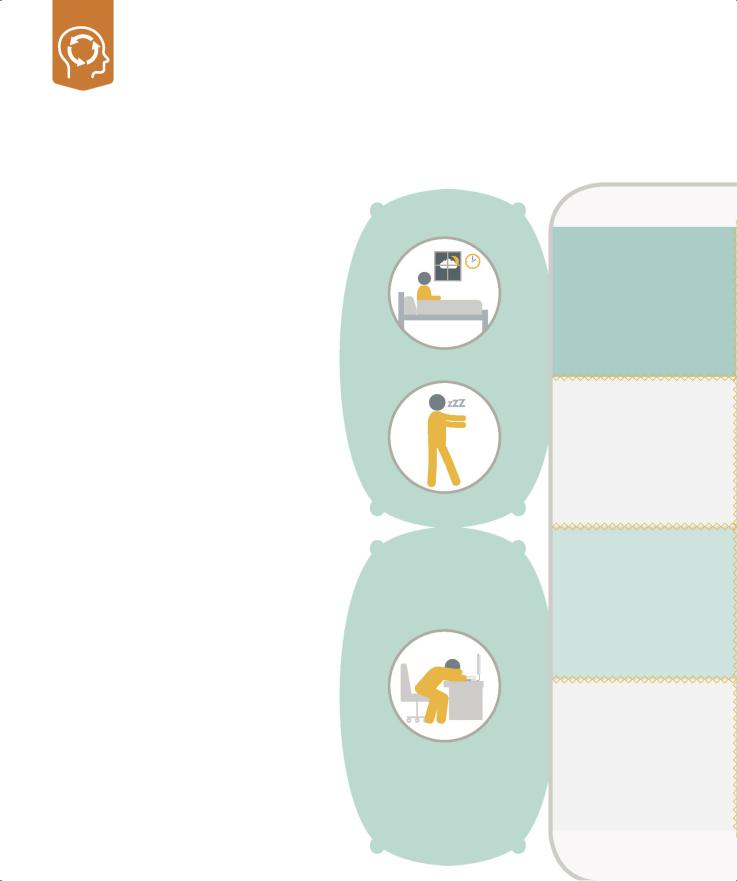
Sleep disorders
This is a group of conditions that affects a person’s ability to sleep well. Their cause may be psychological or physiological, but they can all result in disturbed thoughts, emotions, and behaviors.
What are they?
Most people experience sleep problems from time to time. The problem becomes a disorder if it occurs regularly and interferes with daily life and mental health. Lack of refreshing sleep can have a negative impact on energy, mood, concentration, and overall health— disorientation, confusion, memory problems, and speech disturbances can result, which may in turn worsen the disorder.
Sleep involves transitions between three different states: wakefulness; REM (rapid eye movement) sleep, which is associated with dreaming; and N-REM (non-rapid eye movement) sleep. Disorders include abnormal occurrences not only during sleep but also just before sleep and immediately on waking. For example, a person may have difficulty falling and/or staying asleep (insomnia) and then feel extremely tired throughout the day. A person’s sleep may be disturbed by abnormal behavior or events (parasomnias), such as sleepwalking, nightmares, sleep terrors, restless leg syndrome, sleep paralysis, and sleep aggression. Confusional arousal makes a person behave in a strange and confused way when they wake up. REM sleep behavior disorder is a severe parasomnia that causes sleep-related groaning and often causes a person to physically enact their dreams.
What are the causes?
Sleep disruption can be associated with medications, underlying medical conditions (for example, narcolepsy), and sleep-related breathing conditions. The latter includes a range of anomalies from snoring to obstructive sleep apnea (a condition in which the walls of the throat relax and narrow during sleep, interrupting normal breathing), which causes the person to wake up in distress.
|
|
OM |
|
|
|
S |
N |
|
|
|
I |
|||
N |
|
|
A |
|
I |
|
|
|
|
|
SO |
|
|
A |
M |
N |
|
R |
|
|
|
A |
|
|
I |
|
|
A |
|
P |
|
|
|
|
|
OL |
|
|
|
|
C |
E |
P |
|
|
R |
|
|
|
||
A |
|
|
|
S |
|
N |
|
|
|
|
Y |
H |
|
|
|
|
C |
E |
Y |
|
|
|
N |
|
|
E |
|
|
|
|
|
|
P |
|
|
E |
|
|
|
R |
|
|
|
|
||
|
S |
O |
|
|
|
|
|
|
O MN |
|
|
|
|
WHAT IS IT?
Insomnia is difficulty in getting to sleep and/or staying asleep long enough to feel refreshed the next day. Episodes can be short-lived or continue for months or years. It is more common in older adults.
Parasomnias are a group of unwanted events, experiences, or behaviors that occur while a person is falling asleep, sleeping, or waking. The person remains asleep throughout and has no memory of them.
Narcolepsy is a long-term disorder that can develop if the brain is unable to regulate sleeping and waking. It is characterized by irregular sleep patterns and suddenly falling asleep at inappropriate times.
Hypersomnolence is excessive sleepiness that intrudes on daily functions. It can be mild and transient, or persistent and severe, and it often accompanies depression. It mostly affects teens and young adults.
